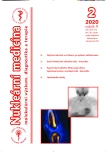Residual activity in the syringe after radiopharmaceutical injection
Authors:
Ivana Kuníková; Otto Lang; Alena Žídková
Authors‘ workplace:
Klinika nukleární medicíny, 3. LF UK a FN Královské Vinohrady, Praha 10, ČR
Published in:
NuklMed 2020;9:22-25
Category:
Original Article
Overview
Introduction: Really injected radioactivity of a radiopharmaceutical is lower than the radioactivity of the syringe prepared for application - disintegration of the radionuclide and residual activity in the syringe take part. Careful application, the low residual activity is a part of it, is a one prerequisite of well performed examination.
Goal: To measure the residual activity under the conditions of our department.
Method: We measured 48 syringes after the injection of 99mTc-HDP with a specific activity of 926.0 to 1050.6 MBq/ml (median (Me) 984.0 MBq/ml). We put the syringe together with a needle into the plastic vial immediately after the injection and perform the measurement in the dose calibrator. Applications were done during 6 days, 8 injections per day, each day by a different staff member.
Results: Residual activity was 17.25 to 95.15 MBq (Me 72.90 MBq), i.e. 2.73 to 14.35 % (Me 8.34 %) of prepared activity. It is 0.02 to 0.10 ml (Me 0,07 ml) converted to the volume. Values of the measured residual activity do not correlate with the volume of radiopharmaceutical prepared for the application (p=0.08). There are also differences of measured values of residual activity among individual staff members (minima 17.25 to 53.48 MBq (2.73 to 5.45 %); maxima 77.46 to 99.15 MBq (9.25 to 14.35 %).
Conclusion: Really injected radioactivity of 99mTc-HDP was mostly about 8 % lower comparing to radioactivity prepared for application. Difference among individual injections are up to 12 %, there are also differences among individual staff members. The optimal technique for minimal residual activity comprises: withdraw a small volume of blood after injection and inject back again; always carefully press the piston of the syringe to the end of the syringe cylinder; to aspire back to the syringe immediately after injection and thus to prevent the leakage of radioactivity into the environment.
Keywords:
radiopharmaceutical injection – residual activity
Sources
- Reynolds SN, Kikut J. Adherence of Tc-99 Sestamibi to Plastic Syringes Could Complicate Efforts in Dose Reduction in MPI SPECTJ Nucl Cardiol. 2016;23 : 256-264
- Keskíntepe D, Özer AY. Residual radioactivity in the syringes used in injection of radiopharmaceuticals and factors affecting the amount of residual radioactivity. J.Pharm. Sci. 2005;30 : 176-180
- Stavrou PZ, Papachristou M, Persakis E et al. Residual activities of 99mTc-labelled radiopharmaceuticals in routine nuclear medicine practice. Nucl Med Commun. 2016;37):658-663
- Jansson BA, Goransson MB, Agren BN. Adsorption of Some Technetium-99m Radiopharmaceuticals onto Disposable Plastic Syringes. J. Nucl. Med. Technol. 1998;26 : 196-199
- Galbraith W, Chen X, Katie Talley K et al. Assessment of 99m Tc-Succimer Residual Activity Using Inert Nonreactive Syringes. J. Nucl. Med. Technol. 2015;43 : 61-63
- McGough ChG, Huang DChT, Hung JC. Comparison of Four 1-mL Syringes for Administering First-Pass Radionuclide Angiography Doses. J. Nucl. Med. Technol. 1999;27 : 227-229
- Kenji S, Noboru A, Tsuneo N et al. Residual activity in syringes after the injection of radiopharmaceuticals. Radioisotopes 1980;29 : 208-214
- Swanson TN, Troung DT, Paulsen A et al. Adsorption of 99m Tc-Sestamibi onto Plastic Syringes: Evaluation of Factors Affecting the Degree of Adsorption and Their Impact on Clinical Studies. J. Nucl. Med. Technol. 2013;41 : 247-252
- Mushtaq A, Rehman T, Mansur MS et al. Adsorption of 99m Tc-Radiopharmaceuticals onto Injection Vials and Syringes. J Nucl Med Technol 2008; 36 : 91–94
- Bartosch R, Granegger S, Sinzinger H. Adsorption of technetium-99m tetrofosmin and technetium-99m furifosmin on plastic syringes. Eur J Nucl Med 1998;25 : 1333–1335
- Stašová J., Marková I, Lang O. Aplikované dávky radiofarmak a průměrná váha pacientů vyšetřovaných na Oddělení nukleární medicíny Oblastní nemocnice Příbram. NuklMed 2015;4,S1 : 26
- Národní radiologické standardy – nukleární medicína [online]. 2020. [cit. 2020-04-23]. Dostupné na: https://www.mzcr.cz/dokumenty/nuklearnimedicina_8773_3050_3.html
Labels
Nuclear medicine Radiodiagnostics RadiotherapyArticle was published in
Nuclear Medicine

2020 Issue 2
Most read in this issue
- Bone infarction as an accidental finding - a case report
- Hyperfunctioning parathyroid gland as a cause of hyperparathyroidism and osteodystrophy – a case report
- Treatment of thyroid cancers with 131I
- Residual activity in the syringe after radiopharmaceutical injection
